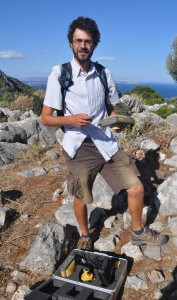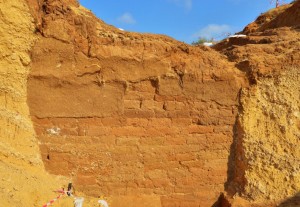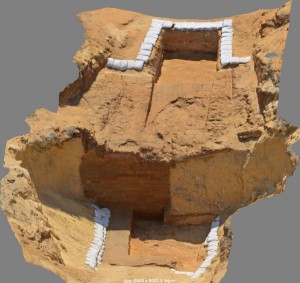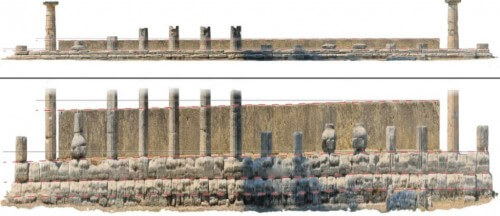In the future we will be able to wear 100D glasses, tour an ancient site, and feel what it looked like during its greatness. Dr. Philip Spierstein, an American researcher who spent the last few years excavating in Israel and Greece was able to decipher in XNUMXD what buildings of which only remnants remained looked like, and on the way to correct the diagrams drawn by researchers from XNUMX years ago.

A new XNUMXD technology may revolutionize the management of archaeological excavations and the analysis of their results - a conversation with the archaeologist Dr. Philip Spearstein from the USA, who is hosted at Tel Aviv University
Imagine a tour of a famous ancient site, Masada in Israel, for example, or Olympia in Greece. Many of you must be thinking right now about a debilitating sun beating down on your head and some stone walls and fallen pillars whose meaning is very difficult to understand. Here and there stands a half-restored building, which may alleviate the heat load but still requires a developed imagination to imagine what Herod's palace or the temple that hosted the ancient Olympic fire looked like. Now, imagine the same tour with semi-transparent XNUMXD glasses on your eyes that enable the presentation of augmented reality. You can still see the ancient remains, but the glasses show you another layer where you can see exactly how the buildings and streets looked in the distant past. In more complex sites, such as in ancient Jerusalem, you can go from the Second Temple period to the Hellenistic period, and from there to the Crusader days, at the push of a button. There is no doubt that such a tour will make the visit an unforgettable experience - and in fact, it will be possible to hold the virtual parts of the tour even from home.
This somewhat futuristic scenario may sound fictional, but archaeologist Dr. Philip Spierstein uses technology that would allow such a tour, and he does it for serious research purposes. Spierstein is staying at Tel Aviv University, in the research group of Dr. Alex Pantelkin, as a post-doctoral researcher within the framework of the Fulbright program. At our meeting he told me about the excavation expedition he participated in in Israel: Ashdod Yam, and about the contribution of the technology he promotes.

In the summer of 2013, the first season of excavations took place at the Ashdod Yam site, located in the southern part of today's Ashdod city. During the excavations conducted under the leadership of Dr. Alexander Pantelkin, on behalf of the Institute of Archeology of Tel Aviv University and in collaboration with institutions from Israel and abroad, the remains of a system of fortifications from the 8th century BC were uncovered, which surround the rest like an anchorage. It is a massive wall of mud bricks (about 4 meters thick) which is the core of a slippery system (like dirt embankments) internal and external. The fortification system is from a time when the Assyrians ruled the southern part of the eastern Mediterranean basin, a rule that was followed by power struggles and wars. Philistine Ashdod is mentioned in Assyrian inscriptions in which episodes of rebellion and resistance to Assyrian rule were mentioned in the late 8th century BC. The Kingdom of Judah, under the rule of King Hezekiah, then rejected Ashdod's appeals to join the rebellion. In response to the rebellion, Philistine Ashdod was severely punished and destroyed by the Assyrian sovereign. As a result, the center of gravity moved from Ashdod itself to Ashdod Yam. In Dr. Pantelkin's opinion, it must be assumed that the remains of the fortifications that have just been uncovered are related in some way to these events.

Excavations in the complex also uncovered the remains of impressive buildings from the Hellenistic period (from the end of the 4th century to the 2nd century BC), which yielded a fascinating find. Spierstein, from the University of Nebraska-Lincoln in the USA, is an expert on ancient Greek architecture. The site in Ashdod Yam interests him and the research group at Tel Aviv University, because it may provide information both on the nature of Assyrian rule in Israel and on connections between Greece and the Levant. In the summer of 2014, the second excavation season is planned to expand the research area.
XNUMXD reconstruction in the field
The research tool with which Spierstein investigates the findings is software that has only in the last three years begun to be used in archaeology, and more specifically in photogrammetry - a technique that allows for XNUMXD mapping of the site through photographs.
In the 19th century, in the early days of archaeology, and before they started using modern research methods, the diggers would come to the site and start looking for finds. "You have to remember that archeology not only reveals but also destroys," explains Spierstein. For example he brings the Olympia site in Greece, where he stayed for a year. "The researchers from the 19th century destroyed most of the remains of a Byzantine Hellenistic city (from the 6th century AD) that was built over the remains of classical and Roman temples in order to get to the remains that interested them." Even today, researchers are forced to destroy findings when they dig deeper, but the rules of excavation have changed - each and every find must be documented with great precision. Until now, they had to stop the excavation, take precise measurements, manually, or if the budget allowed, using sophisticated measuring equipment, such as a laser rangefinder, and film the findings, layer by layer.

At the same time, a technology was developed that allows obtaining 50D information by comparing images. Originally, in the 20s, the method was used for topographic mapping using aerial photographs. The photo analysts would find identical points in the images that covered the same area from a slightly different angle, and analyze the three-dimensional arrangement of the objects in the image. A first computerized digital version of the method was developed in the early 80s for industrial applications. The use of the technique expanded with software improvements in the 90s but it still required many hours of work. However, in the early 2000s the programs became more accepted, and about 5 years ago they began to be combined with computer XNUMXD vision programs and with images from simple digital cameras.
Nowadays, you can find free photogrammetry software on the net, but the professional software with the higher capabilities cost several hundred to several thousand dollars. The software automatically finds millions of points of similarity between images, and you can use any camera, even from a mobile phone. In this way, it is possible to take about 10 photos during the excavation and more on the same day to get a 80D reconstruction of the site. The software saves 90%-XNUMX% of the time and money required by the other methods.
"The method will revolutionize the management of archaeological excavations," says Spierstein. The excavation manager will be able to receive a XNUMXD model of the site every day and decide on the excavation directions the next day. Also, all the data is saved, so that the excavation is documented at a high level of detail and also allows the site to be explored after the work in the field is completed. In the near future, when he returns to the US, Spierstein is considering incorporating XNUMXD printers into the method for teaching purposes.
The Olympic flame
In addition to the reconstruction of the site in Ashdod-Yam, Spirstein shows me some photos from the temple in Olympia where the Olympic fire was lit in ancient times. Spierstein uses the XNUMXD software to reconstruct the structure. In practice, he stayed in Olympia for only two weeks, about a year ago, and since then he has been doing reconstruction on his laptop. "In addition to building the XNUMXD model of the findings, it is also possible to simulate stones that fell and scattered and try to combine them with the remains that are still standing on the furrow, in a kind of XNUMXD puzzle, and enable the reconstruction of the structure," says Spierstein. The software also allows very precise measurements that reveal mistakes in previous reconstructions. If the reconstruction is not done well, it is destructive, and therefore archaeological reconstruction has been made in recent years into a science that stands on its own.
The website in Ashdod-Yam will also need virtual reconstruction. The exposed brick wall will be destroyed if they do not protect it with a large and expensive structure, therefore, at the end of the excavations, the site is covered with dirt again. The only way to continue restoring it would be using a computer.
And what's next? Spierstein believes that within five years the method will be made standard on all sites. He says that the Antiquities Authority has expressed interest and a similar project is underway in Acre as well. The University of Nebraska plans to soon establish a computerized archive that will contain the information from sites around the world and will be available online.
And when Spierstein tells me that similar software is also used in the film industry, we sail on the wings of imagination and see ourselves visiting the Masada during the Roman siege or in the courtyard of the Temple in Jerusalem. Now, using the relatively simple and cheap software, we call on the Antiquities Authority to entrepreneurs to turn our imaginations into reality.
Archaeologist Dr. Philip Spierstein is staying in Israel as part of the American Fulbright Program for the exchange of lecturers and students. Fulbright is the first government program launched to promote scientific ties between Israel and the US. Israel's participation in this program is managed by the USA-Israel Education Foundation (www.fulbright.org.il). The interview was conducted with the assistance of Hila Ovadia-Akerman.
About the author
Dr. Eitan Crane is a chemist who directs the culture-science program at Hamada, the center for scientific education in Tel Aviv. Serves as co-editor-in-chief of Scientific American Israel.
